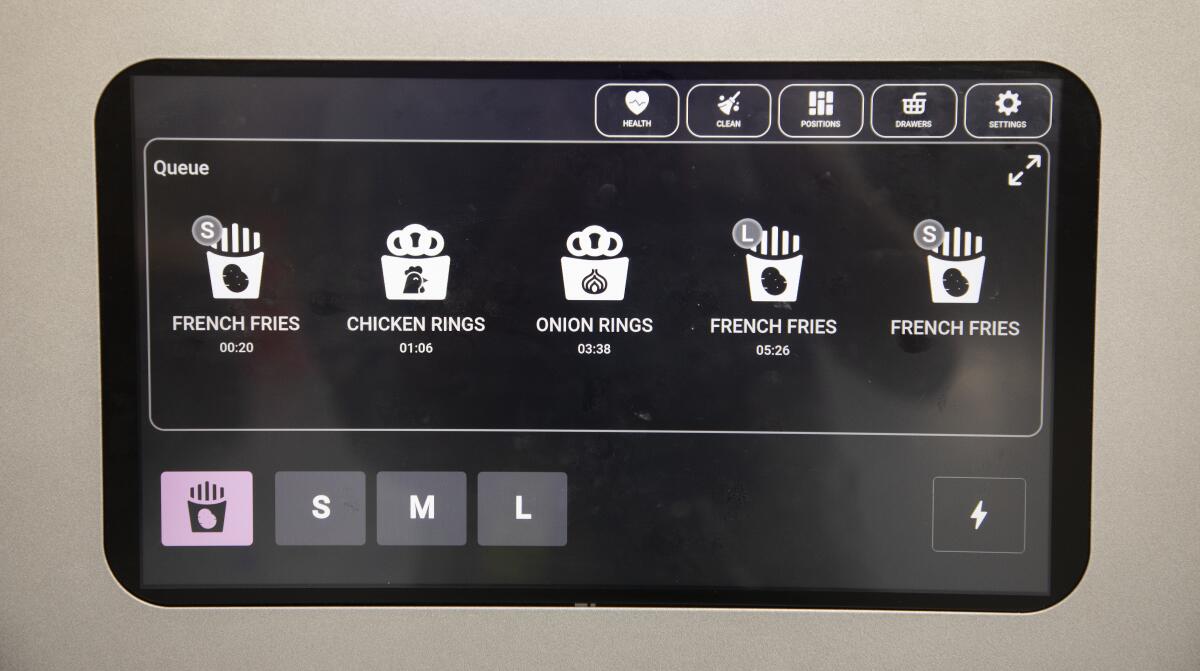Business
Robots can make your fries, salads and guacamole. Is this the future of fast food?

Miso Robotics’ lab in downtown Pasadena is filled with robots of the past and present.
There’s Sippy, Chippy and Drippy. The star of the lab: an updated robot named Flippy that can fry French fries and chicken nuggets much faster than humans.
Miso Robotics has a lot riding on its ability to convince fast-food chains to incorporate Flippy — a robotic arm that drops fryer baskets into sizzling oil — into their kitchens. With the restaurant industry buffeted by higher costs driven in part by rising minimum wages in California and other states, Miso is one of several tech startups betting more businesses will be searching for new ways to save money, reduce employee turnover and fill more orders.
“You’re never going to get rid of humans in restaurants, nor would you want to,” Miso Robotics Chief Executive Rich Hull said. “What you’re trying to do is automate the tasks that the humans don’t enjoy doing.” Flippy can process more than 100 fry baskets an hour, notably faster than the 70 or so baskets the company estimates employees can handle during the same time period. The robot also spares workers from the risk of burns from hot oil or slips on grease.
Flippy the French fry making robot at Miso Robotics
Restaurant chains have been experimenting with robots in the kitchen for years. But, while several companies including White Castle, Sweetgreen and Chipotle are currently testing out ways to automate food prep, circuits and software haven’t yet taken over.
“We are at the very, very early stage. The return on investment has not been proven,” said John Gordon, a restaurant industry analyst who founded Pacific Management Consulting Group. “There’s no doubt an opportunity in some restaurants because of the … repetitive work that is done” out of view of diners.
For some businesses, early results are promising. Los Angeles-based fast-casual restaurant Sweetgreen has been testing what the company calls its “Infinite Kitchen” that uses machines to dispense and mix salad ingredients that humans then put the finishing touches on. Two locations that piloted the technology, including one in Huntington Beach, saw improvements in order accuracy and staff turnover, while average sales were 10% higher, executives said during a recent earnings call.
Miso Robotics, founded in 2016, has tested earlier versions of Flippy in roughly 20 restaurants including White Castle, CaliBurger and Jack in the Box. White Castle, a burger chain with locations primarily in the Midwest and the region around New York City, said it expects to follow through on plans announced last year to roll out Flippy in nearly one-third of its approximately 350 restaurants.

Rich Hull, chief executive of Miso Robotics, demonstrates the latest version of Flippy at the company’s Pasadena lab.
(Al Seib / For The Times)
The field of fast-food robotics is littered with companies that failed in their attempts to disrupt the restaurant industry. Last year, Silicon Valley pizza-making startup Zume shuttered after raising $450 million from SoftBank’s Vision Fund and other investors. Among other problems, the company, which was founded in 2015, reportedly had trouble getting its robots to keep melted cheese from falling off pizzas that were being baked in a moving truck en route to customers. And in 2022, food delivery company DoorDash shut down Chowbotics — the company behind a robotic salad-making vending machine — roughly 18 months after it purchased the startup because it didn’t live up to expectations.
Miso Robotics appears to be at a make or break point, analysts said. As of June 2024, the startup had an accumulated deficit of $122.8 million and meager cash reserves of just under $4 million. The company’s negative operating cash flows have raised concerns about its ability to survive, a report filed to the U.S. Securities and Exchange Commission says.
Hull and other executives started just last year, and former CEO Michael Bell was terminated in May 2023, another filing shows.
As of March, the company has raised $126.5 million from investors and was in the process of raising additional funds, according to data from Pitchbook. Gordon and other analysts said they believe the company’s immediate future rests largely on its ability to raise more cash as it tries to ramp up sales.
Hull, an early investor in Miso Robotics, is a Hollywood film producer and executive who also founded a Spanish-language streaming company Pongalo, which was later renamed Vix.TelevisaUnivision acquired Vix Inc. in 2021. He said Miso’s board and Ecolab, which invested $15 million in the company, brought him in to grow the startup much like he’s done for the streaming business.
“Innovation is not easy. It’s really hard. Now we have a seven-year head start on everybody else, but it’s messy,” Hull said. “I love messy. That’s always been my thing.”
He said the company recently closed a $20 million round of financing.
The company plans to significantly ratchet up its production capabilities next year, making it able to fill whatever orders it receives, Hull said, adding that Miso is aiming to be profitable by the end of 2026.
Some labor analysts question whether automation will help workers. Brian Justie, a senior research analyst at the UCLA Labor Center, visited a restaurant that used Flippy during the summer.
“Whether or not it’s faster or cheaper than a … traditional restaurant, I think what it very clearly was, it was fewer people doing pretty much the same amount of work or more work with a limited menu,” he said.
During a demonstration at Miso Robotics’ lab, Hull highlighted improvements the company has made to Flippy, including making it smaller so it can fit under the exhaust hood and above the fryers in a compact kitchen. And he said the integration of artificial intelligence technology has cut down on food waste and improved durability with the machine able to fix problems with its operating system or alert a customer service representative if it’s about to break down.
Miso Robotics has tested out other robots, which were meant to pour drinks at the drive-through (Sippy) or cook and season tortilla chips (Chippy), but Hull said its engineers are focused for now on the frying robot. Miso initially designed Flippy to flip burgers when the startup unveiled the robot in 2017, but the company changed course when it saw a bigger revenue opportunity with fried foods, he said.
Miso executives believe the frying technology could be a huge boon for the company, claiming in a government filing that “Flippy’s automation of the fry station represents a potentially massive $3.5 billion revenue opportunity for Miso alone in a market that, importantly, still remains fragmented, underdeveloped, undercapitalized, and ripe with growth opportunities for a company with Miso’s first-mover advantage.”
Restaurants can buy or lease the robot, and the company makes money as well from maintenance, software upgrades and tech support. Most customers lease Flippy for $5,000 to $6,000 per month, but various factors can influence pricing, including the number of fryers in a restaurant.
Several chains, including Panera, Jack in the Box, Chipotle and Buffalo Wild Wings, have been testing Miso’s technology since 2021, SEC filings show. Many of the companies declined to detail whether the robots led to cost savings, but they pointed to other benefits.
At White Castle, for example, Flippy robots have allowed employees to better focus on other aspects that improve a customer’s experiences such as order accuracy and hospitality, said Jamie Richardson, the chain’s vice president of marketing and public relations.

A touch screen enables a worker to operate Flippy’s robotic arm.
(Al Seib / For The Times)
The burger chain turned to Miso after realizing workers assigned to the drive-through and fry station had to juggle multiple responsibilities and orders. White Castle also partnered with SoundHound to test an AI voice assistant named Julia (named after a beloved White Castle host named Julia Joyce from the 1930s) to help take drive-through orders. In June, McDonald’s announced it was ending a similar pilot program with IBM amid reports the technology had struggled with people’s accents.
With many variables at play, White Castle hasn’t measured whether Flippy has improved employee retention, Richardson said. So far, it has gotten positive feedback about the robot from employees.
“People who come to us want hot and tasty, affordable food,” he said. “If you can take the pain points out of that, if you can reduce the friction, everybody wins.”
Curt Garner, chief customer and technology officer at Chipotle, said the restaurant chain tested out Miso’s tortilla chip-making robot in one Orange County location from 2021 to 2023. Even though the pilot ended last year, Garner said the restaurant incorporated what it learned into other products.
For the record:
6:28 p.m. Oct. 30, 2024An earlier version of this story incorrectly said James Jordan is president and board chair of Miso Robotics. He no longer holds those roles.
Chipotle, which has a $100-million venture fund, has invested in other startups including Vebu Labs, which was founded by former Miso Robotics’ president and board chair, James Jordan. The partnership produced Autocado, which cuts, cores and peels avocados before workers hand-mash them to create guacamole. It has also invested in San José-based Hyphen to create what the company calls an “augmented makeline” that uses automated technology to build bowls and salads while Chipotle employees make burritos, tacos, quesadillas and kids’ meals.
Jot Condie, president and chief executive of the California Restaurant Assn., said the COVID-19 pandemic fueled more interest in the use of automation and technology in restaurants.
A lot of the adoption, he anticipates, will happen in fast-casual restaurants where convenience and efficiency are key, rather than in full-service restaurants where the interaction with friendly servers is a more important part of the experience.
“Quick service restaurants like Chipotle that have the ability and the resources to invest and adopt technologies will sort of lead the way,” he said.

Business
The Container Store files for bankruptcy amid stiff competition

The Container Store has filed for Chapter 11 bankruptcy protection amid steep losses, slumping sales and increased competition.
Business in its stores and online will continue as usual while it restructures, the Texas-based home goods, storage and custom closets chain said late Sunday. Customer deposits for in-home services will be honored, and merchandise orders will be delivered as normal.
“The Container Store is here to stay,” Chief Executive Satish Malhotra said in a statement. “Our strategy is sound, and we believe the steps we are taking today will allow us to continue to advance our business.”
The Container Store peaked in its 2021 fiscal year, when the company exceeded $1 billion in sales for the first time and posted record earnings as consumers spent heavily on home remodeling and redecorating projects during months of pandemic quarantine. A national de-cluttering craze, set off by organization expert Marie Kondo, also benefited the chain.
But since then, the Container Store has struggled.
Part of the company’s struggles are due to competition from rivals including Target, Walmart and Amazon, which often sell storage items that are similarly stylish at a lower price point. And with housing prices and mortgage rates remaining stubbornly high, many prospective home buyers have been forced to wait on the sidelines, dampening demand for a wide range of products and services that come with outfitting a new property.
For the three months ended Sept. 28, the Container Store reported a loss of $16.1 million. Sales totaled $196.6 million, down 10.5% compared with the same quarter a year earlier. Same-store sales fell 12.5%.
Founded in 1978, the Container Store operates more than 100 stores around the country. In Los Angeles County, it has locations in Century City, El Segundo, Pasadena and Woodland Hills.
It filed for bankruptcy protection in the Southern District of Texas, two weeks after the New York Stock Exchange notified the company that its shares would be suspended for failing to maintain an average global market capitalization of at least $15 million over 30 consecutive trading days.
The Container Store said it expected to confirm a plan of reorganization within 35 days and emerge from bankruptcy soon after as a private company. The company said at least 90% of its term loan lenders had pledged $40 million in new money financing.
The Chapter 11 process does not include Elfa, a separate customized closet business based in Sweden, which is owned by the Container Store.
In an email to customers Monday, Malhotra said the company had felt “the impact of the challenging macro-economic environment” but reassured them that “our obligations to you will be fulfilled as expected.”
“You can feel confident that any orders, deposits or business you have with us are safe,” he said.
It has been a tough month for large-format retail chains. Last week Party City filed for Chapter 11 bankruptcy and said it would close all of its roughly 700 stores nationwide, and Big Lots said it would begin going-out-of-business sales at about 870 stores after a deal to sell the company fell through.
Business
Judge enters default judgment in suit against Kanye West's private school

A judge entered a default judgment against Kanye West’s Christian private school in Los Angeles Superior Court on Wednesday in connection with a lawsuit filed by a former employee.
Isaiah Meadows, Yeezy Christian Academy’s former assistant principal, sought a default judgment in his wrongful termination and unpaid wages lawsuit against the school — later rebranded Donda Academy — and other defendants for failure to appear through licensed attorneys.
The judge, Christopher K. Lui, ruled in favor of Meadows’ motion. He also ruled that the answers given by defendants — Yeezy Christian Academy, Donda Services LLC and Strokes Canyon LLC — in response to Meadows’ complaint be stricken.
Last year, a lawyer representing West, and the three other defendants denied “each and every allegation of Meadows complaint,” in a filing with the court.
In August, Brian Blumfield, West’s most recent attorney who was representing the music mogul and other business entities in the matter, sought his removal from the case on the grounds that the defendants had terminated their relationship in June and that they had refused to speak to or pay Blumfield, according to court filings. The judge granted the request.
Meadows had alleged that he brought many of the school’s health and safety issues to the attention of West and the school’s director. But they were left unaddressed and Meadows was later fired.
According to the complaint, a skylight in one of the classrooms didn’t have glass, allowing rain to fall in the building. West reportedly did not like glass.
“Water would soak into the floor, which would lead to a moldy smell for the next few days.”
Further, electrical and telephone wires were also allegedly left exposed and on one occasion an electrical fire started near a student dining area.
In 2020, Meadows was offered $165,000 salary to work, according to the suit. However, he claimed that West later reneged on his promise to pay for his rent after doing so for three months — Meadows had relocated with his family from North Hollywood to Calabasas to work at the school.
The rent payments ended in February 2021, Meadows claimed after he “was suspended after calling for meetings and raising concerns regarding operations of the school.”
Meadows alleged that his salary was then cut and he was later demoted and worked as a teacher’s assistant and physical education teacher. That April, he sent an email outlining his concerns about his pay and that of other staff members.
Nearly two weeks before the new school year was to start in 2022, Meadows was told that he was being terminated “with no explanation as to why.”
The suit is one of at least five filed against West and Donda Academy since 2023 that allege a hostile workplace as a result of West’s conduct, which includes claims of discrimination and antisemitism, and retaliation, as well as various health and safety issues at the school’s property that was located first in Calabasas, then Simi Valley and finally in Chatsworth.
Donda Academy abruptly shut down in October 2022, amid a cascade of fallout from West’s antisemitic comments, which led a number of his business partners such as the Gap and Adidas to sever ties with him.
There were reports that the school reopened shortly thereafter; however, according to the California Department of Education, the school has been closed since June of this year.
Business
Santa, aka the IRS, might be dropping $1,400 into your stocking this year

Everyone’s favorite Christmas gift giver, the Internal Revenue Service, has announced that it will be doling out more than $2 billion in checks to Americans this month as part of its effort to make sure everyone received their stimulus payments from 2021.
The federal tax agency has announced that an internal review showed many Americans had never received their economic impact payments, which were supposed to go out following the filing of 2021 tax returns. Because of this, the agency is paying out the money they still owe Americans who never received their checks.
Although most eligible Americans received their stimulus payments, the checks will be sent to those who qualified but filed a 2021 tax return that left the space for recovery rebate credit blank.
Those people are eligible for up to $1,400 from the federal government. The payments should be received by late January 2025, at the latest.
“These payments are an example of our commitment to go the extra mile for taxpayers. Looking at our internal data, we realized that 1 million taxpayers overlooked claiming this complex credit when they were actually eligible,” said IRS Commissioner Danny Werfel. “To minimize headaches and get this money to eligible taxpayers, we’re making these payments automatic, meaning these people will not be required to go through the extensive process of filing an amended return to receive it.”
Stimulus payments of $1,400 were sent out to Americans as part of a $1.9-trillion COVID-19 relief bill. Millions of Americans were eligible for the payments.
To get a check, Americans were required to make less than $75,000 per year or under $150,000 as a household.
-
/cdn.vox-cdn.com/uploads/chorus_asset/file/25789444/1258459915.jpg)
/cdn.vox-cdn.com/uploads/chorus_asset/file/25789444/1258459915.jpg) Technology1 week ago
Technology1 week agoOpenAI cofounder Ilya Sutskever says the way AI is built is about to change
-

 Politics1 week ago
Politics1 week agoU.S. Supreme Court will decide if oil industry may sue to block California's zero-emissions goal
-

 Business1 week ago
Business1 week agoFreddie Freeman's World Series walk-off grand slam baseball sells at auction for $1.56 million
-
/cdn.vox-cdn.com/uploads/chorus_asset/file/23951353/STK043_VRG_Illo_N_Barclay_3_Meta.jpg)
/cdn.vox-cdn.com/uploads/chorus_asset/file/23951353/STK043_VRG_Illo_N_Barclay_3_Meta.jpg) Technology1 week ago
Technology1 week agoMeta’s Instagram boss: who posted something matters more in the AI age
-
News1 week ago
East’s wintry mix could make travel dicey. And yes, that was a tornado in Calif.
-
/cdn.vox-cdn.com/uploads/chorus_asset/file/24924653/236780_Google_AntiTrust_Trial_Custom_Art_CVirginia__0003_1.png)
/cdn.vox-cdn.com/uploads/chorus_asset/file/24924653/236780_Google_AntiTrust_Trial_Custom_Art_CVirginia__0003_1.png) Technology3 days ago
Technology3 days agoGoogle’s counteroffer to the government trying to break it up is unbundling Android apps
-

 Politics4 days ago
Politics4 days agoIllegal immigrant sexually abused child in the U.S. after being removed from the country five times
-

 News4 days ago
News4 days agoNovo Nordisk shares tumble as weight-loss drug trial data disappoints















